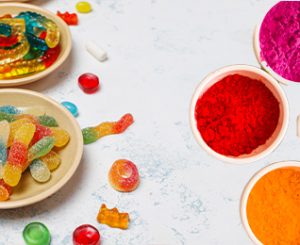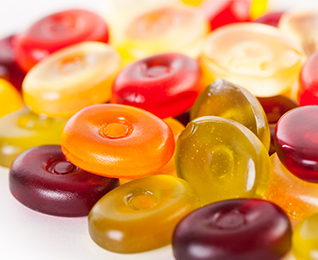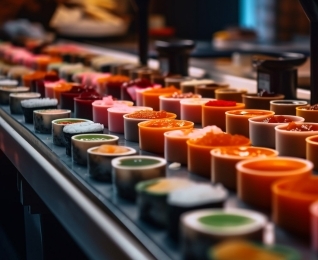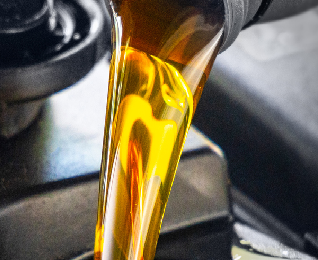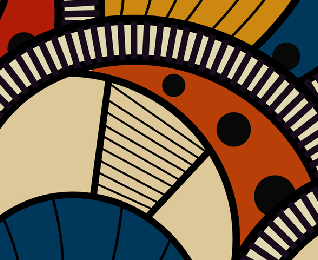Presentation is the key in the food industry...

Lake colours and industrial applications
What are Lake Colours?
Britannica defines lake pigments as, “any of a class of pigments composed of organic dyes that have been rendered insoluble by interaction with a compound of a metal.”
Lake colours or pigments are a type of colourant that is insoluble in nature. They colour by
dispersion. Lake pigments are manufactured from a dye by precipitating the soluble dye with an inert binder or mordant which is usually a metallic salt.
Lakes are able to be dispersed in oil (though they mostly don’t dissolve in oil). Hence, they can be mixed with oils, fats and sugars.
Lakes are also colour stable which means that they can resist bleeding. Bleeding refers to the property of dyes transferring from one part of the product to another.
Difference between Lakes, Dyes, and Pigments
Lake colours are a type of pigment and they differ in property from pigments in general and dyes.Let us understand the differences:
- Lake colours are made by precipitating dyes with a metallic salt and they are insoluble.
- Pigments are those types of substances that are used to impart colour to other materials.They are both organic as well as inorganic and they are not soluble in nature. They are Ultra Violet stable.
- Dyes are chemicals that also impart colour to other materials, similar to pigments. The difference lies in their solubility. Dyes are water-soluble and they show colour when dissolved in water. They are easily dispersible and can’t mix with oil.
How are Lake Colours used in different Industries?
We at Saujanya Exports being lake colour manufacturers and exporters are heavily involved in colours and pigments and hence we possess extensive knowledge about the uses of lake colours. Lake colours have the advantage of being able to be utilized in many different industries and diverse applications. Let us find out about them:
1. Cosmetics Industry
Aluminium lake colours are usually used in the cosmetics industry. They are used to provide tints and colours to various cosmetic products. While makeup products are where lake colours have the greatest potential, lake colours are used in other parts of the cosmetics industry as well.
In makeup, lake colours are quite useful as they don’t bleed colour unlike dyes and they also result in very bright hues which is a big benefit in makeup. A few products where lakes are used are:
– Eye Products – Eyes are one of the most mobile parts of the body and so, such pigments are needed that won’t smudge due to blinking. Lakes come in here as the ideal choice due to
their stability and insolubility.
– Lip Products – Owing to their insoluble nature, lake colours resist the bleeding of colours
which makes them perfect for making the best lipsticks.
Nail Products – Due to their colour stability and insolubility, lakes are perfect to impart colours onto nail polishes.
– Blushes – Lake colours result in bright intense colours that are also available in powder form,this is great for using them in the manufacturing of blushes.
Lake colours used in this industry include Brilliant blue lake, Amaranth lake, Sunset yellow lake,Indigo carmine lake, Quinoline yellow lake, Allura red lake, and others.
2. Food Industry
The food industry has vast applications for colour additives. Colours are used in just about every food product in present times and lake colours are no different. Colours are added to the food product during the manufacturing process. Some areas where food colours are used are:
- Confectionaries
- Bakery Products
- Dairy Products
- Desserts
- Seasonings
- Spices
- Beverages
- Pet Foods
Food colours come in 2 types; dyes and lakes. Dyes are used in various products like dairy, pet food,beverages, and are water-soluble. They are available in the form of powders, granules or liquids.
Lakes come in both natural food colors as well as synthetic food colours. They are insoluble in nature and so they are beneficial to be used as colourants in foods that are oil-based and fat-based or those which contain oils and fats. They are also useful in products that have less moisture like the coatings of tablets, cheese, margarine, chewing gum, chocolates and others. A commonly used lake pigment in the food industry is Aluminium lake. Furthermore, synthetic food colours include Tartrazine, Sunset yellow, Allura Red, etc, and natural food colours include organic caramel, beta-carotene, carmine (which is extracted from bodies of insects) etc.
3. Textile Industry
Dyes and pigments don’t play a part in the actual manufacture of textiles, rather they are used in the textile industry to impart colour onto fabrics and textiles after the products have been made. While not many lake colours are used in this industry, one of them which is used is a type of aluminium lake made from plant extracts. This industry has a higher usage of dyes (some of which can also be used to make lakes as well). They are:
– Mordant dyes and Acid dyes:
- Mordant dyes are a type of dye that require a mordant to adhere to the fabric. This
enhances the fastness of the fabric dye against light, water, and perspiration. These dyes are
used to colour fabrics like polyester, silk, rayon, acrylic wool, and nylon. - Acid dyes are used to colour protein fabrics and fibres like wool and silk.
- These 2 dyes can form insoluble salts with metal ions from metals like calcium and
aluminium hence becoming lakes.
– Basic dyes:
- Basic dyes are also called cationic dyes. These dyes are commonly used to dye fabrics like silk, nylon, wool, and other acrylic fabrics.
- They have amino groups and are have the capability to form insoluble salts with inorganic metal-containing acids like phosphotungstic or phosphomolybdic acids. These are then used for printing in textiles
4.Plastic Industry
Lake colours along with other colourants have a wide application in the plastic industry. They are all used to impart colour onto the following materials among many others:
- PVC
- Optical lenses
- Acrylic
- Plastic filaments and sheets
- Nylon
- Polyester resins
- Polyamide
- Polypropylene
- Polycarbonate
- ABS
Colourants play an important role in the plastic industry as they are a necessary part of the
manufacturing process and they also play an integral part in the functionality of a product. But adding such colourants can have an adverse effect on the inherent properties of plastic like its impact strength. So, the additives need to be chosen carefully
Both dyes and pigments are used in the industry, though the usage of lake pigments is comparatively lesser than other dyes and pigments. Dyes that are used for plastics, need to be strong, have heat stability and be transparent. Pigments that are used, can be either organic or inorganic. In the end, whatever is chosen needs to be compatible with the base resin so as to prevent colour shift with time.
The following types of pigments are used in the plastic industry:
- Organic pigments
- Inorganic Pigments
- Carbon black
- White pigments
- Special effect pigments
- Aluminium pigments
- Others
Within these families of pigments, organic lakes like BONA Lake and Naphthol Lake are used.
Other than this, many research papers have found and concluded the potential of natural lake pigments in the plastic industry as they have the capability to be used as useful eco-friendly colourants for plastics.

